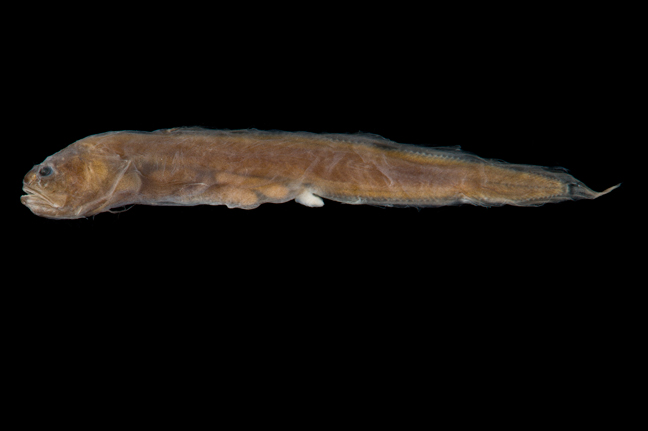Timorichthys disjunctus Nielsen & Schwarzhans 2011

Timorichthys disjunctus. Source: Jørgen G Nielsen. License:
Timorichthys disjunctus is one of two species in the family Bythitidae in having the anus positioned midway between the snout and the anal-fin origin. T. disjunctus also has a body that does not taper towards the caudal peduncle, the opercular spine covered by skin and a unique head pore pattern.
The species is known only from a single specimen, 39 mm SL in length, collected in 2007 from the Timor Sea off northwestern Australia.
Timorichthys disjunctus Nielsen & Schwarzhans 2011
More Info
|
Distribution |
Endemic to continental slope waters of the Timor Sea, off northwestern Australia, approx. 78 km south of Cartier Island, 13°13’29’’S, 123°23’44’’E to 13°13’20’’S, 123°23’17’’E, in 392 m. |
|
Features |
Meristic features: Dorsal-fin 74; Anal fin 46; Pectoral fin 11-12, Pelvic fin 1; Caudal fin 11-12; Vertebrae 16+36= 52; Pseudobranchial filaments 2; Anterior gill arch with 6 long rakers. Head pores: 3 anterior infraorbital pores, a pair of anterior mandibular pores at lower jaw symphysis and 1 posterior mandibular pore behind termination of maxilla. Origin of dorsal fin above vertebra no. 9, origin of anal fin below vertebra no. 24 and dorsal fin ray no. 28. Anus placed below dorsal fin ray no 3. Body long slender, non-tapering and compressed; dorsal and anal fins continuous with caudal fin; head short, snout blunt, mouth oblique, ending well behind eye. Anus positioned midway between snout tip and anal-fin origin. Scales and lateral line absent. Pectoral radials not prolonged. Weak opercular spine covered by skin. Anterior nostril close to upper lip, ending in distinct tube. Palatines with few, small teeth. Few, large head pores. Otolith with a small, undivided, centrally placed sulcus. |
|
Size |
Known from a single male specimen measuring 39 mm SL. |
|
Colour |
Head and body dark brown with numerous, tiny, black spots most dense on snout, cheek and jaws. Eye bluish with greenish lens. |
|
Feeding |
Unknown. |
|
Biology |
The sexes are separate and all bythitids have internal fertilization and are live bearers. The male has a copulatory organ that is part of the large broad fleshy genital hood. The penis is a small, soft free papilla and lacks pseudoclaspers. |
|
Fisheries |
|
|
Conservation |
|
|
Similar Species |
Differs from Timorichthys angustus, the only other species of the genus (found in the East China Sea), by having the pectoral fin peduncle equal in length to its width (vs. much longer than width in T. angustus), precaudal vertebrae 16 (vs. 22), total vertebrae 52 (vs. 62), long rakers on first gill arch 6; (vs. 14), horizontal eye diameter 1.3 % SL (vs. 3.1 % SL),interorbital width 303 % SL (vs. 0.8 % SL), posterior mandibular pore present (vs. absent), anterior infraorbital pores 3 (vs. 1), opercular spine covered by skin (vs. not covered by skin ), otolith height to thickness 1.8 (vs. 2.5), and head and body dark brown in alcohol (vs. light brown). (Nielsen et al. 2013) |
|
Etymology |
Timorichthys refers to the Timor Sea, the type locality. The species name disjunctus is Latin, meaning separated or distant, and refers to the position of the anus midway between the tip of the snout and the origin of the anal fin. |
|
Species Citation |
Timorichthys disjunctus Nielsen & Schwarzhans 2011, The Beagle, Rec. Mus. Art Gallery N. T. 27: 144, figs 1-3. Type locality: eastern Indian Ocean, Timor Sea, off northwestern Australia, approx. 78 km south of Cartier Island, Kulumburu L29 transect, 13°13’29’’S, 123°23’44’’E to 13°13’20’’S, 123°23’17’’E, R.V. Southern Surveyor, Sherman sled, 392 m. |
|
Author |
Dianne J. Bray |
Timorichthys disjunctus Nielsen & Schwarzhans 2011
References
Nielsen, J.G., Okamoto, M. & Schwarzhans, W. 2013. A new species of Timorichthys (Ophidiiformes: Bythitidae) from the East China Sea. Ichthyological Research DOI 10.1007/s10228-013-0341-3 (Abstract)
Nielsen, J. & W. Schwarzhans. 2011. A new genus and species of Bythitidae (Teleostei: Ophidiiformes) from northwestern Australia. The Beagle, Records of the Museums and Art Galleries of the Northern Territory 27: 143-146.

